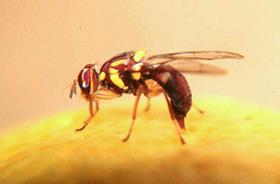
Five live male fruit flies have been trapped on Flinders Island, off the coast of Tasmania – Australia’s most southern state. The trapping follows detections of fruit fly larvae at three sites on the island earlier this month.
Queensland fruit fly has been confirmed at the first site on Flinders Island and genetic testing is continuing for the other two sites.
Another unconfirmed detection of larva was made last week in the Spreyton district on Tasmania’s north coast – a popular apple growing area.
The number of fly’s teeters on the edge of concern as any more than five detections is determined to be an ‘outbreak’ according to domestic and international standards.
Cherry grower, Tim Ried, told ABC News that the detection was very serious and could mean millions of dollars in financial and job losses for the Tasmanian economy – if the fly were to spread across the state.
Currently, a widespread baiting program is taking place both on Flinders Island and in the Spreyton area.
“To give us confidence in eradication of fruit fly we have to know that we have broken the life cycle of them,” said Lloyd Klump, general manager of the Department of Primary Industries, Parks, Water and Environment Biosecurity Tasmania.
“These adult male flies have been detected within a 200m zone that we had put in place around the site where larvae were detected.”
Trees in both control areas, which include the Furneaux Group Islands (Flinders Island) and the greater Devonport area (Spreyton), will have bait applied to their leaves to attract and kill any present fruit flies.
Currently, no fruit is allowed to move from inside the control zones without protocol treatments. Fruit grown outside control areas is free to move as long as it is accompanied by the appropriate paperwork. For non-protocol countries, fruit can still be traded from either zone.
It takes around four weeks for flies to multiply, so if there is an incursion in Spreyton it will become visible over the following month.
Tasmania has suffered a fruit fly threat in 2011, and New Zealand in 2015. Both instances were controlled and each area’s pest-free status restored.
The Tasmanian Government has promised financial assistance to growers impacted by fruit fly biosecurity operations.



